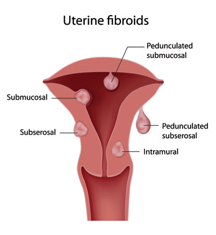
Transcervical Resection of a fibroid (TCRF)
It is a procedure of removing fibroids located on the internal lining of the uterus (womb) using a hysteroscope. This procedure is suitable for fibroids that are within or bulging into the uterine cavity (submucosal). Any fibroid tissue within the uterine wall will not be removed. TCRF aims to remove the fibroids that cause menstrual problems or that may be interfering with the ability to conceive. The procedure is usually done under general anaesthesia, and is done either as a day case or as one night hospital stay for recovery.
Submucous fibroids are located just underneath the endometrium (lining of the uterus) and bulge into the uterine cavity. Submucosal fibroids can vary in how much of the fibroid bulges into the uterine cavity and how much is in the muscle of the uterus. They often cause heavy bleeding and long periods, but can also cause irregular bleeding.
TCRF involves shaving away the bulging part of the submucous fibroid using a resectoscope under hysteroscopic guidance. When the procedure is done for heavy periods or irregular menstrual bleeding, improvement is noted in lighter and more regular periods that become noticeable over the subsequent 2-3 months. Where TCRF is undertaken for fertility, although the chances of pregnancy may improve, the ability to conceive depends on many other factors, and therefore may be difficult to predict who would be successful after the procedure.

